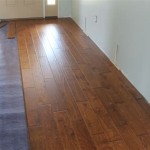How To Install Laminate Flooring on Concrete
Installing laminate flooring over a concrete subfloor is a popular and cost-effective way to enhance the aesthetics and comfort of a space. Laminate offers durability, ease of maintenance, and a wide range of styles mimicking hardwood, tile, and stone. However, proper preparation and installation techniques are crucial for a successful and long-lasting result. This article provides a comprehensive guide to installing laminate flooring on concrete, covering essential steps from subfloor preparation to final finishing touches.
Before embarking on the installation process, it is imperative to gather the necessary tools and materials. A well-stocked toolkit will streamline the project and minimize potential delays. Essential tools include a tapping block, pull bar, measuring tape, pencil, circular saw or laminate cutter, hammer, utility knife, moisture meter, and safety glasses. Required materials encompass the laminate flooring itself, an underlayment suitable for concrete, moisture barrier (if not integrated into the underlayment), spacers, and transition pieces for doorways and other areas where the flooring meets existing surfaces.
Key Point 1: Preparing the Concrete Subfloor
The preparation of the concrete subfloor is arguably the most critical step in the entire process. A properly prepared subfloor ensures the longevity and performance of the laminate flooring. The primary focus is on achieving a clean, level, and dry surface.
The initial step involves thoroughly cleaning the concrete floor. This includes removing any existing debris, such as dirt, dust, paint splatters, adhesive residue, or loose particles. A broom, vacuum cleaner, and scraper can be used to accomplish this. For stubborn adhesive residue, a specialized adhesive remover may be necessary, following the manufacturer's instructions carefully.
Once the floor is clean, assess it for levelness. Concrete floors are rarely perfectly level, and significant variations can cause the laminate flooring to flex and potentially separate at the seams over time. Use a long level (at least 6 feet) to identify any high or low spots. Place the level on the floor in various directions, noting any gaps visible between the level and the concrete surface.
Minor imperfections (up to 3/16 inch in 10 feet) can often be addressed with self-leveling compound. This pourable mixture fills low spots and creates a smooth, even surface. Follow the manufacturer's instructions meticulously when mixing and applying the self-leveling compound. Ensure the compound is thoroughly dry before proceeding to the next step. For more significant level discrepancies, grinding down high spots may be necessary. This requires specialized equipment and expertise, and it may be prudent to consult with a professional flooring contractor.
Moisture is a significant concern when installing laminate flooring over concrete. Concrete is porous and can wick moisture from the ground, which can damage the laminate over time. A moisture test is essential to determine the moisture content of the concrete slab. A concrete moisture meter is used to measure the moisture level. Readings should be within the laminate manufacturer's specified range, typically below 3 lbs/1000 sq ft/24 hours using a calcium chloride test, or below a certain percentage using an electronic meter. If the moisture levels are too high, remediation is necessary. This may involve applying a concrete sealer or a more robust moisture barrier specifically designed for this purpose. Allow the sealer or barrier to cure completely before proceeding.
Key Point 2: Installing the Underlayment and Moisture Barrier
The underlayment serves multiple crucial functions when installing laminate flooring over concrete. It provides a cushioning layer, reduces noise transmission, and, in some cases, includes an integrated moisture barrier. The choice of underlayment depends on the specific needs of the installation and the manufacturer's recommendations for the laminate flooring being used.
If the underlayment does not have an integrated moisture barrier, a separate moisture barrier must be installed. This is typically a polyethylene film, which is unrolled over the prepared concrete subfloor. Overlap the seams of the film by at least 6 inches and tape them securely with moisture-resistant tape. The moisture barrier should extend up the walls slightly, which can be trimmed later after the laminate flooring is installed.
Once the moisture barrier is in place (or if using an underlayment with an integrated barrier), the underlayment can be installed. Most underlayments come in rolls and are simply unrolled across the floor. Some underlayments have a peel-and-stick adhesive that makes installation easier. Overlap the seams of the underlayment according to the manufacturer's instructions (if any) and tape them with the appropriate tape. Ensure the underlayment is lying flat and smooth before proceeding.
It's crucial to select an underlayment compatible with concrete. Some underlayments are specifically designed to handle the unique challenges of concrete subfloors, such as moisture and unevenness. Avoid using underlayments that are not recommended for concrete, as they may not provide adequate protection or performance.
Consider the acoustic properties of the underlayment. If noise reduction is a priority, choose an underlayment with a high Impact Insulation Class (IIC) rating. This rating indicates the underlayment's ability to reduce impact noise, such as footsteps, from transmitting to lower levels.
Key Point 3: Laying the Laminate Flooring
After the subfloor and underlayment are properly prepared, the laminate flooring installation can begin. Careful planning and attention to detail are essential for a professional-looking result. Start by planning the layout of the flooring. Consider the direction of the planks, the location of doorways, and any other architectural features that may affect the installation.
It is generally recommended to run the laminate planks parallel to the longest wall of the room, as this typically creates a more visually appealing and spacious effect. However, other factors, such as the direction of natural light, may also influence the decision. When laying the first row of planks, use spacers along the walls to maintain an expansion gap. This gap allows the flooring to expand and contract with changes in temperature and humidity, preventing buckling or warping. The size of the expansion gap is typically specified by the laminate manufacturer, usually around ¼ to ⅜ inch.
Most laminate flooring systems utilize a click-lock mechanism, which allows the planks to snap together easily and securely. Follow the manufacturer's instructions carefully when connecting the planks. Be sure to angle the planks correctly and apply even pressure to ensure a tight and seamless fit. Use a tapping block and hammer to gently tap the planks together if necessary, but avoid excessive force, which can damage the locking mechanism. A pull bar can be used to tighten the seams along the walls where the tapping block cannot reach.
When cutting laminate planks, use a circular saw or a specialized laminate cutter. A circular saw equipped with a fine-tooth blade will provide clean and accurate cuts. A laminate cutter is designed specifically for cutting laminate flooring and can make quick and easy cuts without creating dust. Always wear safety glasses when cutting laminate flooring to protect the eyes from flying debris.
As the installation progresses, stagger the end joints of the planks to create a more visually appealing and structurally sound floor. Avoid placing end joints directly next to each other in adjacent rows. A minimum stagger of 6 inches is generally recommended. Cut the last row of planks to fit the remaining space, again leaving an expansion gap along the wall. Use a utility knife to trim the excess moisture barrier and underlayment along the walls.
Finally, install transition pieces at doorways and other areas where the laminate flooring meets existing surfaces. Transition pieces provide a smooth and seamless transition between different floor coverings and also help to protect the edges of the laminate flooring. Secure the transition pieces according to the manufacturer's instructions, typically with adhesive or screws.
After the installation is complete, inspect the floor for any gaps, imperfections, or loose planks. Address any issues promptly to ensure a long-lasting and satisfactory result. Clean the floor with a damp mop and a laminate floor cleaner according to the manufacturer's recommendations. Avoid using excessive water or harsh chemicals, as these can damage the laminate flooring.

Laminate Flooring On Concrete Basement Floors Expert Installation Guide Csg Renovation

Installing Laminate Flooring Over Concrete The Ultimate Guide Aa Floors

Installing Wood Flooring Over Concrete Diy

How To Install Vinyl Or Laminate Floors In A Basement Over Concrete Slab

Installing Laminate Flooring For The First Time Home Renovation

How To Install Laminate Flooring On Concrete Making Maanita

How To Install Laminate Over Concrete Day 1

How To Lay Laminate Flooring On Concrete Howtospecialist Build Step By Diy Plans Laying Installing

How To Install Laminate Over Concrete Day 1

Easy Ways To Install Vinyl Plank Flooring On Concrete
Related Posts








